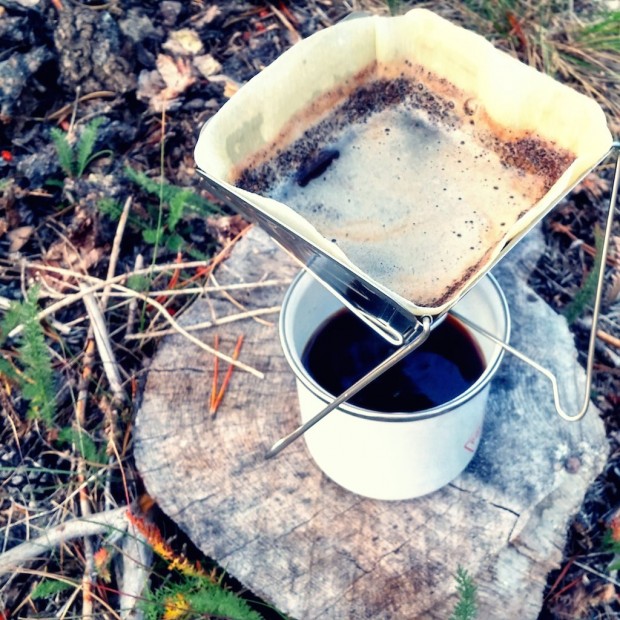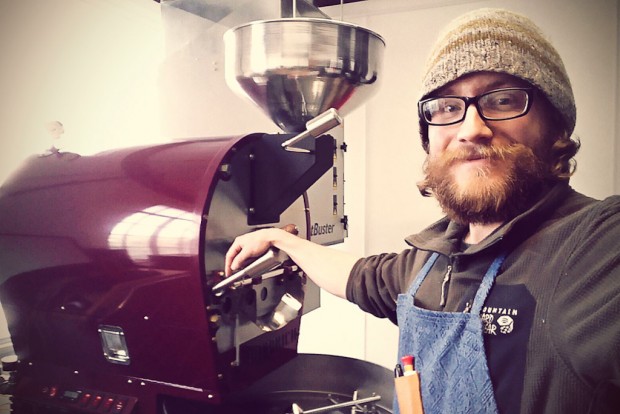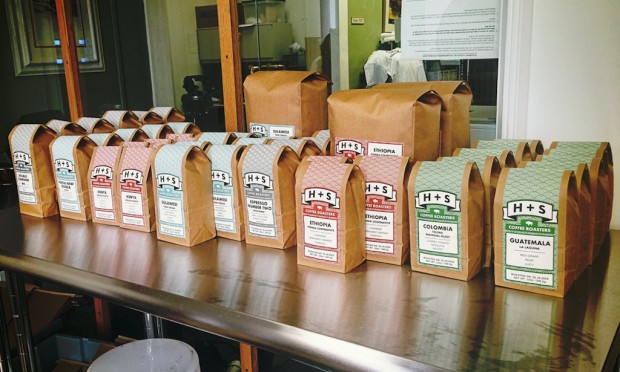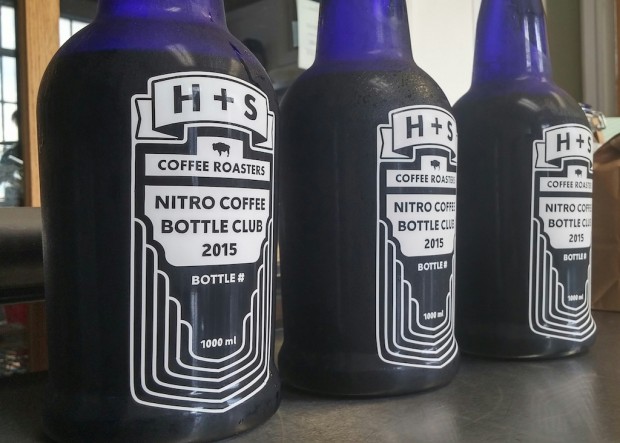The state of Wyoming’s rugged, expansive beauty spans more than 97,000 square miles. It’s the ninth largest state in the U.S. by land mass, yet with just shy of 600,000 residents as of the 2013 census, it is also the nation’s least populous. So while the city of Laramie enjoys a youthful college-town spirit care of the University of Wyoming, plus a couple local microbreweries, an arts scene and some increasingly creative cuisine, it is nevertheless still a very remote, country town, far from the competitive culture of bigger city hotbeds.
Yet, geography alone is not the only thing setting Laramie apart. There’s also topography. At 7220 feet of elevation, things are different in the science department. The boiling point is lower, and in the coffee labs of the Laramie-based H+S Coffee Roasters, Cofounder and Head Roaster Coulter Sunderman finds that he has to grind a bit finer. “It’s hard sometimes when we talk to people, and I’m at elevation and I always have been,” Sunderman told Daily Coffee News, “I tell people, ‘brew at 195.’ And everyone says, ‘oh, but why not brew at 205?’ And I say, ‘well, I can’t brew at 205, because that’s boiling water.'”
How differences in air pressure and climate at elevation affect the roasting process in a comparative sense is a matter better suited for physicists, chemists and perhaps climatologists, not that the endeavoring minds at H+S are the kind to shy away from research. In fact it is precisely the freedom to explore new ideas and new technologies that they relish in being not only a small, new and independent company, but one that is well separated from the influences at play in the international coffee vanguard.
At the same time, thanks to the information and resources readily available on the Internet, H+S hardly exists in a vacuum. “As a small business in a small town, we definitely take advantage of the things that we can,” said Sunderman, who regularly samples roasted coffees from beyond the horizon to see what’s happening among specialty coffee circles. “We do try to stay up with the trends of what people are doing, but we don’t really have a direct contact with the culture itself,” said Sunderman, who characterizes H+S not as isolated as much as beneficially insulated from the distractions and pressures of more intensely competitive market landscapes.
“I think we’re allowed a very clear view of what we want to do, what’s our direction as a company,” said Sunderman. “What I really enjoy about where we’re located is that if we get a crazy idea one day, we can sit down and experiment and carry it through. Those experiences are really powerful to us as a company, as we learn new things, kind of on our own.”
“One thing we’re starting to do is examining the relationship between our yellow stage and its percentage to the total roast time, and comparing that with our first crack and its development time or percentage versus the total roast time,” said Sunderman, who hones his craft largely in the absence of the instant sounding board of fellow roasters that other companies might enjoy in more densely populated areas. “I’m assuming that other people are looking at that, too, but I’m not really talking with people about what their findings are. And that may be another thing that’s kind of nice about being out here in the middle of nowhere, because again, there’s a freedom there. We have the freedom to explore this relationship. We have no idea if it’ll bear any fruit, but if it does, then we’ve learned something excellent and we’ve gone about it our own way.”
H+S Coffee Roasters was cofounded by Sunderman and Head of Distribution & IT Joshua Heien in Laramie in July, 2014, in order to follow their passion for coffee with a flexibility for experimentation they felt might go against the grain at the town’s other established roaster — Coal Creek Coffee Roasters, whose standards and procedures are pretty well refined after running shop for more than two decades.
“That’s where I got my start,” said Sunderman. “I started working there as a barista, and became a roaster there and moved up to become the roast master there for a while.” Today, H+S’s Diedrich IR12 roasts batches of roughly the same size as the Primo roasting machine at Coal Creek. Retail bags are sold primarily through the local Big Hollow Food Coop in Laramie, plus a couple cafes wholesale accounts.
Internet retail beyond city limits is growing steadily for H+S, which is key to their long-term survival. “When we started this roaster we knew would have to get a market outside our local market. We knew that it had to happen for us to be successful. It’s a very slow process, for sure,” said Sunderman, who noted that recent online reviews and a story by Wyoming Public Radio have all helped boost the brand’s exposure. “We push social media as much as we can, we try to show people our world and our perspective and what it’s like not just to roast coffee in Wyoming, but to live in Wyoming, and to hike and to camp and to explore Wyoming.”
The Internet may also prove critical to their sourcing practices going forward. Currently H+S orders greens from Café Imports and occasional small quantities bags from Coffee Shrub, although the handful of new web-based farm-direct auction platforms hold significant interest to a company like H+S. “We’re looking at some of these new exchanges that are popping up,” said Sunderman, who is especially interested in Newcrop.co, an online split-lot bidding platform that specializes in smaller, more accessible quantities for micro roasters.
As a roaster in a region where “cowboy coffee” is a matter of cultural identity, a couple blends with roastier profiles are non-negotiable. H+S nevertheless takes particular pride in the single-origins they offer, which is where their passion for profiling R&D really flourishes. “Coffee has a fingerprint, and we try to keep that fingerprint intact,” said Sunderman. “I’ve heard a saying that once coffee goes in the roaster, you can only make it worse.”
That is not to say that H+S is any more adamant about roasting lightly than to any other degree across the spectrum, noting that if a coffee is sold as a single origin, it will have no roast level attached to it in its product description. “We don’t quantify ours as being very lightly roasted, or medium roast, or city or full city or anything like that. It’s really just about what is going to make that coffee taste the best.”
Another indication of their pursuit of perfection is the in-house cold-flashing technology H+S pioneered for preparing cold coffee. “We’re brewing it hot through a Fetco, and then we run it through a flash chiller that’s similar to a wort chiller that a beer-maker might use,” explained Sunderman. “We flash chill it right at the spout, at our brewing temperature of about 195. We get that down to about 70 degrees or so, straight into a keg. Then we continue to chill that keg down to about 40 degrees, and then inject it with nitrogen. And it’s phenomenal.”
“I think cold brew has some shortcomings, as far as the availability of flavor,” said Sunderman. “When you brew it hot and then chill it down very rapidly, you keep intact a lot more of the full fingerprint that the coffee has.” This, coupled with the creamy mouthfeel of the nitro-pressured tap, adds up to a beverage that’s all at once refreshing, complex and satisfying. Said Sunderman, “We can’t make it fast enough. We sell five gallons in about four hours at our local farmer’s market.”
Time will tell if their cold coffee breakthrough — which they first introduced in July 2015 and the process for which Sunderman has made “open source” on the H+S blog — will transcend the weather and prove to be a year-round hit at the bookstore café in town that will continue to serve it as seasons change. H+S is also pursuing bottling for their flash-chilled coffee for sale on the local coop shelves, and then potentially expanding that product line to include a sort of New Orleans-style coffee, with chicory added to the grinds in the brew basket prior to brewing.
“H+S stands for our last names,” said Sunderman. “But we also sometimes like to tell people that it stands for the heart and the science. It’s the combination of the two. It’s about our passion and our creativity and our craft, but we also are looking at the science of what’s going on here, and we blend the two together.”
Howard Bryman
Howard Bryman is the associate editor of Daily Coffee News by Roast Magazine. He is based in Portland, Oregon.












Comment